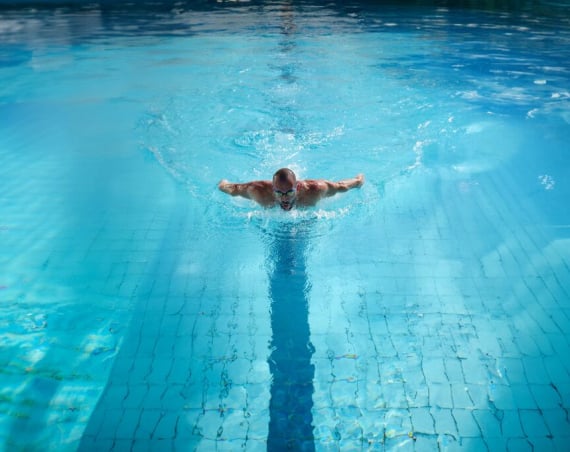Every runner knows that a workout doesn’t end when you’ve reached the end of your route. Putting in the extra time and effort for post-run recovery is the key to ensuring you continue to run comfortably and keep working towards your next best.
Your ideal post-run recovery routine can vary based on the length and difficulty of your run — and whether or not you’re training towards a specific goal. However, there are some basic principles that apply to all post-run recovery systems. Here are the most important things to focus on while you come down from your runner’s high.
Stretch before and after your run
If you’re an avid runner, you know the effect tight muscles can have on your form and run times. Running specifically targets the quads, hip flexors, hamstrings, glutes and calf muscles. That means stretching these muscles both before and after a run is essential to improve flexibility, increase joint mobility and reduce the risk of injury.
Before a run
Dynamic stretches before a run will warm up your body, loosen your muscles and make recovery a breeze. Try each one of the following stretches for 30 seconds:
Inchworm
Start in a standing position. Put your hands on the floor and walk out into plank position. Walk your feet forward towards your hands and repeat.
Targets: hamstrings, chest, shoulders
Frankenstein walks
Start standing tall. One at a time, kick each leg forward as straight as possible, reaching your opposite hand towards your foot.
Targets: hamstrings
Butt kicks
Start in a tall standing position and alternate kicking your heels towards your bum.
Targets: hamstrings, glutes
High knees
Run-on the spot, lifting your knees high enough to touch the palms of your hands.
Targets: calves, quads, hamstrings
Leg swings
Let your leg swing forwards and backwards to loosen up your hip.
Targets: hip flexors, hamstrings, quads, glutes, calves
After a run
After you’ve finished your run, your muscles are full of lactic acid. Static stretching will help speed up recovery and reduce any pain and stiffness. You need to stretch fully whether your workout went well or you had a bad run. For each of the following stretches, try holding them for a minimum of 30 seconds:
Quad stretch
Find something steady to hold onto. With your knees together, bring your right foot to your right hand and tip your pelvis under bringing your heel to your bum.
Modification: To make it a little easier: kneel on the ground in front of a wall and bring one knee up the wall with your foot pointing upwards. Lift your chest up as high as you can and notice the stretch in your quad.
Calf stretch
Standing upright, step forward with one leg and bend at the knee until you feel your back leg begin to stretch.
Modification: Find a step and stand on it with both feet. Drop one heel off the edge until you feel your calf stretching.
Glute stretch
Standing upright, take your right foot and put it across your left knee. The deeper you sit, the more you’ll feel the stretch.
Modification: Sitting on the floor, bring your left leg in and cross your right leg over, using your left arm to pull your right leg in (also called “the pretzel”).
Hip flexor
Come to a kneeling position and step one foot forward leaning into the front leg. To increase the stretch, step your front foot forward even further.
Hamstring stretch
Standing straight up, step one heel forward and sink your bum back and down, bending the back leg.
Modification: Standing straight up, step one foot forward with your heel on the ground and toe pointing up. Bend your standing leg to sink your bum down towards the ground.
Upper back
Standing up straight, clasp hands together and reach forward, rotating to one side and then the other.
Lower back
On your hands and knees in a tabletop position, bring your belly button up as high as it will go, rounding your back. Then let your belly button drop for a concave back position. Slowly alternate from one position to the other.
Refuel your body
After a run, your body is working with low glycogen levels, depleted electrolytes and muscle inflammation caused by micro-tears. Choosing the right food will replenish essential nutrients as soon as possible, which helps your body move through the recovery process and come out stronger.
Protein is the number one macronutrient to focus on post-run. The general guideline is to aim to consume between 10 and 20 grams of protein within 30 minutes of your workout. Here are a few simple snacks to keep in mind:
- A protein shake or a fruit smoothie with protein powder
- Greek yoghurt with berries and granola
- Nut butter on toast or paired with an apple
Of course, make sure to rehydrate with plenty of water. If you’re consistently doing intense runs, especially outdoors in higher temperatures, consider adding a beverage with electrolytes to your routine to ensure your levels are bouncing back before you head out on your next run.
Give your muscles some attention
After you’ve stretched and refuelled, focusing on sore muscles with percussive massage techniques can be a game-changer. Percussive massage uses rapid and repetitive pressure combined with vibration therapy to relax tight muscles and minimize soreness and tension. A massage gun like Theragun can help you target specific muscles and speed up your recovery time. We offer David Lloyd Clubs members an exclusive discount on purchasing a Theragun. Ask at reception to find out more!
If you’re interested in full body massage as part of your routine, experts advise waiting until a couple days after an intense workout. Active release, Swedish massage, trigger point and deep tissue massage are a few options to consider. Consult with a Register Massage Therapist (RMT) to come up with a treatment plan that works for you and your goals.
Want to take advantage of our spa facilities to up your post-run recovery game? Explore what your local David Lloyd Club has to offer.
*This video was produced with the help of Adam Salter, Experience Manager at David Lloyd Beckenham. Watch more content featuring Adam with our workout for tennis players.
Find a club



